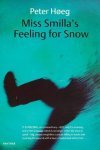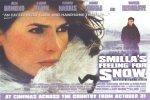About
About The Site
About Fanlistings
About The Book
About The Movie
About Smilla
An Interview With Author Peter Høeg
Quotes
Book Links
Movie Links
Other Links
Update Your Information
The fanlisting for the movie Smilla's Sense of Snow was originally opened on January 18th 2005, by Sofie, who kindly allowed me to adopt it in August 2005. I opened the fanlisting for the book and joined the two. I'm Tehomet. If you have any questions or comments, drop me a line. To see what other projects I am interested in, go to my domain. Thank you for visiting.
A fanlisting is simply a place for all fans of a particular subject to come together and build the biggest listing of people from all around the world who are fans of that subject. To my mind, it's a great excuse to build a little tribute to a favourite book and movie. :) There are over 50,000 fanlistings in existence and the number is growing all the time. Some are simple fanlistings and some are part of a much bigger website. Find out more about the fanlistings phenomenon at the Fanlistings Network.
About The Book

The novel Smilla's Sense Of Snow was written by Peter Høeg, and was first published in 1992. He was already well-known in his home country of Denmark, but the international success of the novel gave him world-wide recognition.
Smilla's Sense of Snow topped the best-seller lists in many countries. Time, People, and Entertainment Weekly magazines all selected it as their "Book of the Year" for 1993. The book spent 26 weeks on the New York Times Bestseller list. It was his third book but the first to be translated into English.
Depending on the translation, the novel was sometimes titled Miss Smilla's Feeling For Snow, as you can see from the English edition's cover on the left.
About The Movie
Made in 1997 and starring Julia Ormond (First Knight, Legends Of The Fall, and Sabrina) and Gabriel Byrne (Miller's Crossing, The Usual Suspects), the movie version of Smilla's Sense Of Snow had the expectations of a huge global audience of fans who had already loved the book to live up to. The problem with making a movie of a book whose major strength is characterization rather than action, is portraying the interior world of the main character. I think the movie succeeded in this, largely thanks to a terrific performance by Julia Ormond, although those who were expecting Smilla The Action Hero might have been a bit disappointed! :)

The movie was directed by Bille August, the Academy Award winner for Pelle the Conqueror and director of The House of the Spirits. He explained in an interview in the Danish paper Berlingske Tidende when asked how he handled the ending, which is unclarified in the book, that "I tried to make a happy ending for Smilla and the Mechanic... but it seemed banal and constructed. Thus the film ends like the book. Smilla is a person who seeks clarification but at the same time she is very unsentimental... The audience reacts positively on the exotic, the magical and the mystical. It is Smilla's character and clear-clearsightedness, her intelligence and bitterness, her relationship with the boy and her father that fascinates. It is Copenhagen, it is Denmark and the whole Arctic world which is the beauty and the greatness of the film."
About Smilla
Smilla is the main character of the movie and book Smilla's Sense Of Snow. In Smilla Jaspersen, a woman whose mother was Inuit and whose father is American, and who has been resettled in Copenhagen, Peter Høeg has created a very unusual character. Smilla is tough-minded, resourceful, and independent.
She is a glaciologist by profession and lives a solitary life in a Copenhagen apartment block. But a little boy called Isaiah, a member of the impoverished Greenlandic community, has befriended her. When the little boy is found dead, face down in the snow after falling from the roof of the apartment building, the police shrug the incident off as a tragic accident. But Smilla knows better. She knew Isaiah and knew that he had a phobia about heights. And her uncanny sense of snow tells her that his footprints on the snow on the roof aren't those of a playing child, but those of a hunted creature.
She sets out to find out why Isaiah was murdered. Along the way, Smilla finds out that Isaiah had been medically examined every month during his life, and that a needle biopsy had been taken from his body before the autopsy. She discovers that his father died in mysterious circumstances on the ice cap and she tracks down the huge corporation whose shady dealings seem mixed up in the deaths of both Isaiah and his father before him. The trail leads to the Artic, so she stows away on an ice breaker ship going on a polar expedition, and risks her life to find out the truth.
Julia Ormond played Smilla in the movie. "It's quite unusual to see a woman on screen who is as complex as Smilla," Ormond said, "Somebody who was uncompromising, who was intelligent, and who was tough and aggressive at different moments, but also deeply vulnerable underneath."
Smilla is aided in her struggle by the Mechanic, a nameless and enigmatic man who also knew Isaiah. The Mechanic was played by Irish actor Gabriel Byrne in the movie. "This man has no name, he has no back story, he comes from seemingly nowhere," Byrne said. "And yet, he is in a strange way the kind of deus ex machina of the whole thing, that he's the one pulling the strings that makes the action progress."
An Interview With Peter Høeg (Note: This interview is © Random House Publishing.)
Peter Høeg was born in Denmark in 1957. He travelled widely, and enjoyed a variety of careers including dancing professionally, acting, sailing, fencing, and mountaineering, before he turned seriously to writing. He lives in Copenhagen with his family and reputedly has no telephone, television, or car.
Interviewer: When did you start writing?
Høeg: There is a day of change in the life of most authors... That is the day they go from writing poems and short stories to working on a novel and writing for several hours every day. I'm thirty-six now; I must have been about twenty-four or twenty-five when I reached that turning point. I'd written for years before that but had never sent anything to a publisher.
Interviewer: How many years did it take to finish your first novel?

Høeg: My first novel took four years to write, but that doesn't say anything about the quality or the size of the novel. It was a learning piece, an apprentice book, because writing is not just a talent but a skill. It's something you have to learn and develop. It's a slow process.
Interviewer: What was the inspiration for Smilla's Sense of Snow?
Høeg: I had two dreams about Greenland. I'm interested in dreams but I don't usually base anything in my life on them. Dreams are too flimsy and unstable for that. Still, these were very strong dreams. Some dreams seem to stay in the mind for years with a clarity that approaches that of real life. Before that I had had almost no contact with Greenland. I knew something about it, because Greenland used to be a Danish colony. I grew up in a very poor part of Copenhagen where there were many Greenlanders. So it was a part of my cultures of course, but it was not something I was that interested in. Out of these two dreams grew a certain feelings and I knew I had to write this book.
Interviewer: You had visited Greenland before then?
Høeg: Yes, I had visited Greenland before, but only for very short periods of time and went back for longer visits while I was writing the book.
Interviewer: The book is so vivid in its descriptions of Greenland that it feels like a lifetime interest.
Høeg: I received valuable help from the Greenlanders living in Copenhagen. Without their help, the book could not have been written.
Interviewer: What about Smilla? Readers are amazed that this is a woman written by a man. Is she the first female narrator you have created?
Høeg: Yes, she is. The book is the first long text in the first person that I tried to write. I think now, in hindsight, that it is an attempt to get close to my inner self. That is the hard part for me, not technique. I have a barrier that goes up whenever it gets very personal. This book is somehow an attempt to get in touch with my feelings. Nobody is just one sex. To live in this world and love a woman, you have to have some kind of understanding of the other sex or mutual consciousness. The use of language is one way of getting closer. The portrait of the woman was very important to me. Writing as a woman is an illusion. It was difficult but it was also fun. Longing for a woman is one of the strongest moving forces in the life of a man, so maybe writing this book was an attempt to get closer to a woman, to explore the landscape of a woman.
Interviewer: You had a number of other professional lives or interests before making writing your full-time occupation. You were a professional ballet dancer, fencer, and seaman for a number of years.
Høeg: My life now is much more quiet that it used to be. Doing a lot of things can also be an expression of restlessness. It's difficult to write a book and be restless. To write big books you have to have a kind of calm. I grew up in a welfare society and a book like this one about Smilla is something that has to be understood within the framework of a welfare society. I was given the opportunity to write full-time for two years without having to do anything else. My parents gave me the opportunity to follow different interests and I've been grateful for that. Writing a book like Smilla's Sense of Snow -- which uses language and images from many different areas of human life -- would not have been possible otherwise.
Interviewer: You've done a great deal of traveling all around the world. That seems clear in your writing. It doesn't have just a Danish perspective. Where have you been?
Høeg: Many places in the tropics. For me, one of the main themes of Smilla is a portrait of a woman standing between two cultures. As society becomes more global, as colonies achieve independence, we see more interracial marriages, and children grow up standing in two cultures. My wife is African, which means my daughter, in a way, is in the same situation as Smilla. Less problematic, I should hope, but still... What kinds of problems do the parents face? What can be done to keep both cultures intact? That is why the character Smilla became the person she is in the book.
Interviewer: Your daughter speaks both Danish and her mother's native language?
Høeg: Yes. One of Smilla's problems is language. I hope by painting a black picture of Smilla's problems I shall avoid the same problems with my daughter.
Interviewer: You've arranged your life in a way ideal for a writer, especially for Americans who can't imagine life without an answering machine. You don't have a phone, and you spend a good part of the year outside Denmark. Is spending time traveling a plan for the future, too?
Høeg: It is not to avoid people; it is an attempt to find balance. The book is the slowest art/media form. Everything else is very fast, but a book is very slow. It took me two years of working full-time to write Smilla, and I have packed into that one small object a lot of energy and concentration. Now that it is finished, it is waiting to explode, to blow up. To pack in that energy and keep in that wave of tension that has built up for a couple of years, I had to have a lot of calm and quiet in my personal life. On the other hand, I like the public. Every book begs for people to read it, to listen to it. I like contact with readers. But there's a risk in becoming a public or semi-public person, because it can invade your life until you lose your concentration. So I try to find a balance.
Quotes
Smilla: "I think more highly of snow and ice than love. It's easier for me to be interested in mathematics than to have affection for my fellow human beings."
Smilla to Elsa Lubing: "The way you have a sense of God, I have a sense of snow."
Book Links
Amazon's page for the book. This page has some customer reviews that are well worth reading.
Qanik by Sarah Stella is a Smilla's Sense Of Snow fanfiction. It is a crossover between the book and the TV show The X-Files. It's rather a nifty casefile, and you don't have to have seen the TV show to enjoy it. (By the way, if you know of any other Smilla fanfiction, please let me know. Thanks!)
Movie Links
IMDB's page for the movie. Rich in technical and cast detail.
RottenTomatoes.com has a page of movie reviews.
Other Links
Sofie, the originator of the movie fanlisting.
Tehomet.net, the homepage of Tehomet, the owner of this fanlisting.
Update Your Information
Already a member and want to update your information? Go here.
